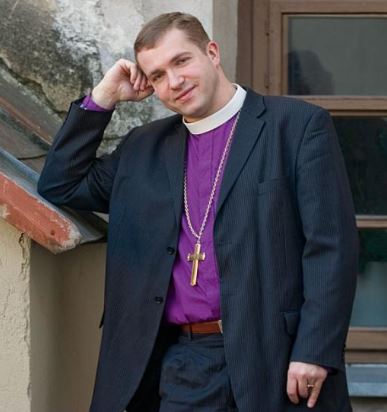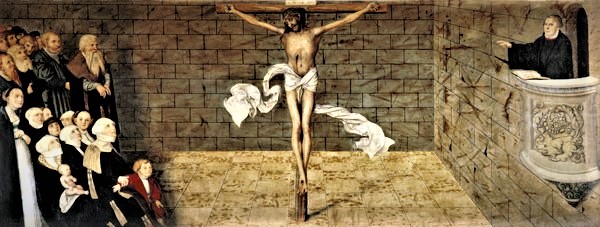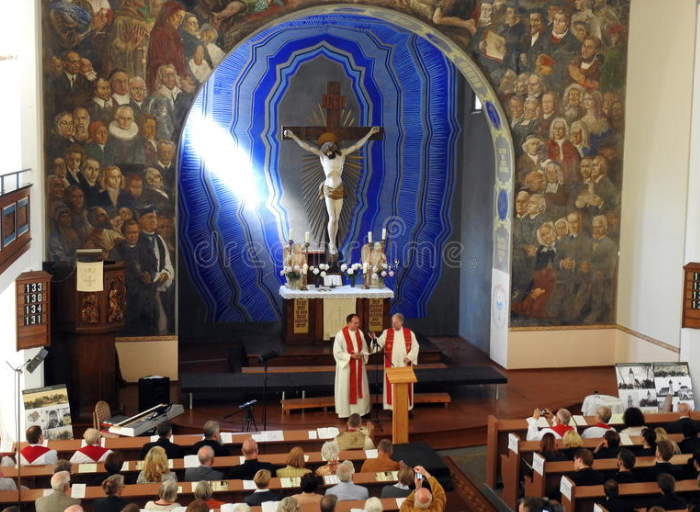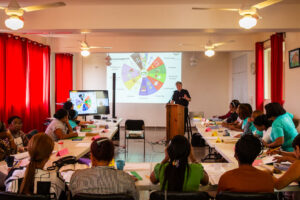
The parishioners of Palanga parish church, member of the Evangelical Luterana Church in Lithuania (ELCL), celebrated this past Ascension Day—post COVID-19 lock down—at their home church adorned with a brand-new crucifix.
A brief history
The Evangelical Lutheran Parish of Palanga was founded at the beginning of the 19th century. It used to be a part of Kretinga parish. Beginning in 1910, the congregation would gather for worship at the home of pharmacist Oskar Berting. Later, a spacious room on the second floor of Berting’s house was renovated. Here, the congregation held services for 18 years. The community at that time consisted primarily of Lithuanians, Latvians and Germans. Pastors were required to prepare their sermons in three languages.
The first Lutheran sanctuary in Lithuania was built and consecrated in 1928 on Jūratės Street. But in 1938, the Soviet government forced the local parish to cease operating. The ten-year old church was burned down by the soviets. The parish was not restored until 55 years later, in 1993.
In 2000, the parishioners petitioned the Palanga city municipality, who kindly allocated a plot of land on Saulėtekio Street for the construction of a brand-new church building. The new church was architected by Irena and Gintas Likšas.

In 2005, Bishop Mindaugas Sabutis consecrated the cornerstone of the new building, which has been Palanga parish’s home church ever since.
Dedication of a new crucifix
While designing the new church in Palanga, the Likšas architects designated the wall behind the altar to be a space for an important Christian symbol. In 2019, the Palanga parish decided that a crucifix would be the most vital figure to hang there.
On May 24th of this year, the Palanga church decorated the wall behind the altar with their long awaited crucifix—the essential representation of Christianity testifying to the atoning work of Jesus Christ crucified for the salvation of all who believe in Him.
The crucifix bears witness to the Christocentricity of Lutheran theology. This is vividly reflected on the altar painting at St. Mary’s Church in Wittenberg by Lucas Cranach, resident artist and church Elder there. The painter depicts Martin Luther preaching the Word of God. In the center of the painting, between the preacher and the congregation, Cranach shows Christ on the cross to whom Luther is pointing with his right hand. In this ecclesiastical masterpiece, Cranach emphasizes the central principle of the Lutheran Reformation—solus Christus; a declaration that salvation is by faith in Christ alone, and that He is the Savior, Lord, and King.

The practice of using a Crucifix among Lutherans
During the Reformation, the Lutheran Church preserved the crucifix that was in use by the early Christian church. Lutheran reformers disagreed with those who argued the cross should exist, but without the corpus (the body of Christ). The Lutheran reformers rejected such radicals as Andreas Karlstadt, who attempted to remove crucifixes from all of the churches, referring to them as “pagan idols.”
The crucifix that now adorns the altar in the Palanga parish church was carved out of oak by sculptor Mantas Paulauskas (from Vilnius, Lithuania). This is not the first such work of art created by this sculptor. Senosios Varėnos Roman Catholic Church is adorned with a three-meter cross with the corpus of Christ carved by Paulauskas.
Throughout Lithuania, crosses depicting the corpus of Christ adorn the Lutheran churches of Tauragė, Jurbarkas, Šilutė and others.

The crucifix of the Šilutė church stands out from the rest with its impressive corpus of Christ.
In several Lutheran churches throughout Eurasia, the crucifix is characteristically affixed above the altar. The same practice is followed in Lithuania.
Web post attribution
This post is a revision of a previous article written by Rev. Dr. Darius Darius Petkūnas, Lutheran pastor and member of the presidium in the consistory of the Evangelical Lutheran Church in Lithuania (ELCL). Petkūnas is author of six monographs and thirty articles in peer-reviewed academic journals.


